Bird bye bird
-
Karen Gideon
-
I’m a birder and a gardener so in the spring when I seed my garden and fertilize fruit trees, I wonder who will reap what I sow. Will it be the crows eating my baby lettuces in a gulp? Or blue jays carrying off my strawberries? While I thank the birds for feasting on slugs and caterpillars, I also employ tactics to ensure that my fruit and veggies reach my table instead of a bird’s beak.
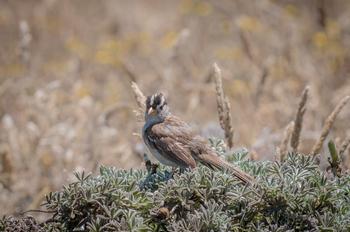 Sparrows naturally eat grass seeds and small berries so they might find your garden seeds appetizing as well. Photo: Karen Gideon
Sparrows naturally eat grass seeds and small berries so they might find your garden seeds appetizing as well. Photo: Karen GideonSome of the worst offenders are our common backyard birds such as crows, house finches, robins, scrub-jays, and crowned sparrows. These are birds I enjoy listening for and watching. So, it helps to focus on ways to deter and exclude birds without losing their pest patrolling and melodic company. We can learn from small farmers and fruit growers how to protect our plants by repelling, frightening the birds, and isolating the trees, vines and plants.
The first step is to make sure that you are not attracting birds to your garden. Check the area around your vegetable garden or fruit tree. Consider removing bird attractants such as bird baths, bird houses and feeders to locations away from fruit trees or vegetable beds. If you want to continue to feed birds, it may help to move your feeder a good distance from the edible garden.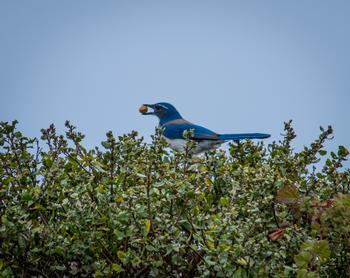 Scrub-jays may poke and pull seeds before they sprout and remove the whole plants after they leaf. Photo: Karen Gideon
Scrub-jays may poke and pull seeds before they sprout and remove the whole plants after they leaf. Photo: Karen GideonA common bird deterrent is the use of visual scare tactics. Birds are quick to react and to escape sudden movement and loud sounds. The flutter of shiny mylar ribbons can unnerve the most curious scrub-jay. You can also use whirligigs. Twirling in the wind, some are created as objects d’art and can be placed throughout the garden. Foil pie plates attached to branches with string may have the same effect.
Scarecrows placed in the garden may frighten a few birds. But they must be moved around weekly to be believable. Placing owls and rubber snakes in the garden have some short-term effectiveness but also must be moved to appear real. Combining visual repellents with auditory noisemakers can increase their effectiveness. While orchard managers may set off loud devices, local suburban gardeners typically use windchimes or rotating noisemakers.
Birds are smart and can figure out the scary source is fake and habituate to the sounds of most noisemakers and visual scare tactics used in a suburban environment.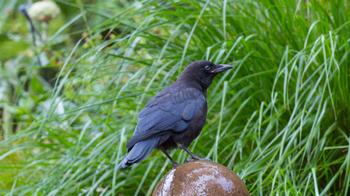 Crows are among the most curious and smartest birds. They habituate quickly to devices used for frightening birds. Photo: Karen Gideon
Crows are among the most curious and smartest birds. They habituate quickly to devices used for frightening birds. Photo: Karen GideonChemical repellents rely on noxious odors, hot and bitter tastes, and other sensual aversions. Keep in mind that you are applying the repellent to a food source you will later consume and you don’t know how the birds will respond to the chemicals as they could make the birds sick. Instructions must be followed carefully. And the efficacy of these repellents is uncertain.
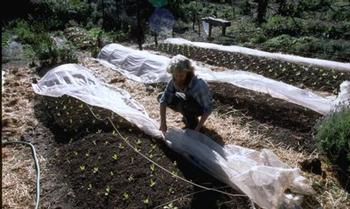 Covers and netting on freshly planted garden soil can be held aloft with hoops or simple framing to keep birds out. Photo: Courtesy of UC Regents
Covers and netting on freshly planted garden soil can be held aloft with hoops or simple framing to keep birds out. Photo: Courtesy of UC Regents
The most effective way to reduce the damage caused by birds is to use quarter to half inch netting or/and fencing to keep your plants isolated. To protect newly planted vegetables or seedlings, a chicken wire cage or netting can keep the birds at bay. The key is to find a row cover or netting that allows pollinators through and keeps birds out. The floating row covers are easily placed over the bed of veggies with or without a frame. Typically, after the plants reach maturity, the protection can be removed. Protective covers may limit your ability to check on the plants regularly or to irrigate easily unless you use drip irrigation.
For fruit trees and vines, tenting with protective netting requires a frame or tent structure to keep the cover from resting on the branches. Place the protection high and wide because birds can perch on the edges and eat the fruit through the netting. There will be some initial costs in building the frame, however, the frame and netting may be reused.Birds provide natural pest control in the garden. When discouraging birds from causing havoc in your garden, either through scare tactics or netting, remember you may lose the benefit of their voracious appetites for slugs, beetles, and caterpillars.
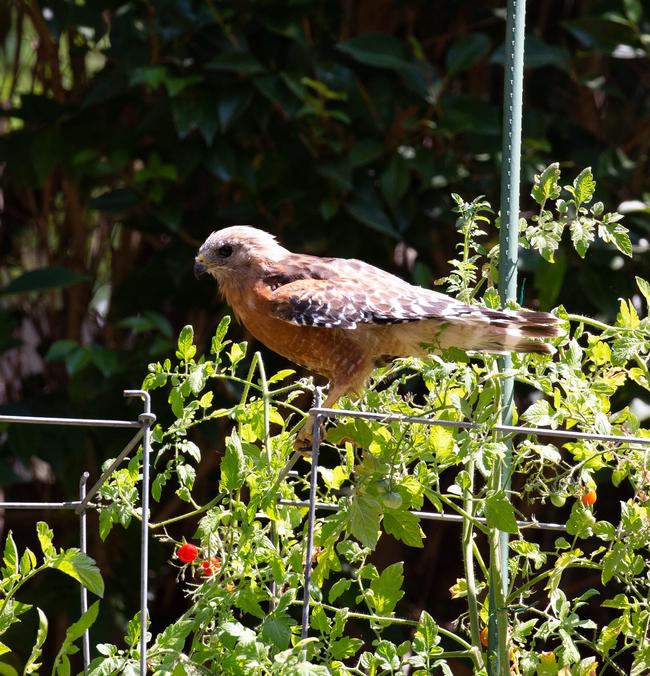 While some birds may be a garden nuisance, hawks can help keep your garden pest free. Photo: Mark Gideon
While some birds may be a garden nuisance, hawks can help keep your garden pest free. Photo: Mark Gideon





